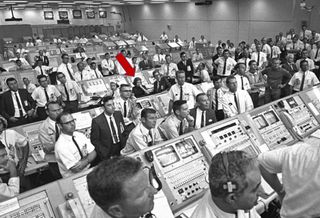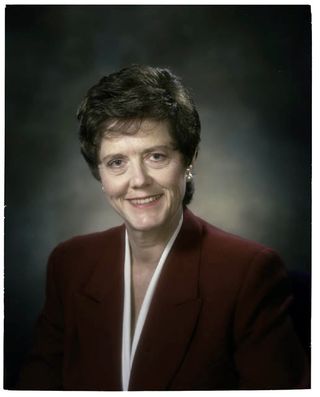'Get Used to it' — The Women Who Broke Through Apollo's Glass Ceiling
They had to deal with a lot of "mosquitoes."
WASHINGTON — Last Thursday (Sept. 12), three women who were critical to the success of the Apollo program spoke at the Smithsonian National Air and Space Museum here about their experiences as scientists and engineers at NASA.
At the museum's 2019 John H. Glenn Lecture in Space History, moderator, museum director and former NASA chief scientist Ellen Stofan spoke with Poppy Northcutt, an engineer and "computer" who worked as the first-ever woman in an operational support role in mission control during Apollo 8, JoAnn Hardin Morgan, an aerospace engineer who was the only woman working in the firing room for Apollo 11, and Carolyn Leach Huntoon, who directed and conducted medical research at NASA and was the first American woman to serve as director of NASA's Johnson Space Center.
Related: These Amazing Women Made NASA's Apollo Missions Possible
The three panelists were additionally joined by a surprise last minute guest in the audience — Marion Lee Johnson, a Black History Month honoree, legendary "hidden figure" and engineer who calculated trajectories for the Saturn V rocket and was integral to the success of the Apollo program.
JoAnn Hardin Morgan

The panel, which commemorated the 50th anniversary of NASA's Apollo lunar missions, began with a video showing the museum's "Go for the Moon" event, which recreated the Apollo 11 lunar landing.
"I knew at the time of Apollo 11 I was working on something incredibly important," Morgan, who additionally became the first woman to serve as a senior executive at NASA's Kennedy Space Center, said at the panel. To a diverse crowd containing a number of hopeful, inspired young women, Morgan spoke about how she was a math whiz in school and became more interested in space with the discovery of the Van Allen Belts.
"In my mind, I thought, this is profound new knowledge for everybody on our planet and this whole launching business and going to space ... it's gonna change the world I live in and I am getting in on it," she said.
Get the Space.com Newsletter
Breaking space news, the latest updates on rocket launches, skywatching events and more!
Morgan discussed her career and how the few women who worked in higher-level technical positions like her all knew each other and banded together, despite working in different departments. She also touched on the fact that, while she was the only woman in the firing room during Apollo 11, which happened about a decade into her career at NASA.
While she had been working diligently behind the scenes for years, the recognition that came with being in that all-important seat made a big difference in her professional career.
Mosquitoes
Touching on the subject of harassment, Morgan also told the story of how a supervisor once "whacked" her on the back and told her that women were not allowed to be in the room that she had been instructed to work in. She later encountered that same man while she sat working in the firing room.
Morgan said that she encountered "everything from obscene phone calls to men following me in the stairwell ... like mosquitoes," she said. "We had a lot of mosquitoes."
"Poppy" Northcutt

Northcutt, who calculated the return-to-Earth trajectories for Apollo, followed Morgan's inspiring words, saying that no one ever told her she couldn't be there, except, of course, society as a whole. "I guess I didn't really appropriately get the message," she joked.
Telling the crowd about her vastly different entrance into the world of human spaceflight, Northcutt said that, "unlike JoAnn, I did not have this big plan to be in the space program."
After receiving her degree in mathematics from the University of Texas, "I found a job as a 'computress' — that really was the job title!" she said, eliciting surprised giggles from the audience. She worked in this role at TRW Systems, a contractor for NASA.
"I thought, a gendered computer? What is this? I had never heard such a title before in my life," she said, referencing the term "computer" which was used in the film "Hidden Figures" and additionally in "World War Two, when women were used as cypher-breakers. They too were called computers or computresses."
"Get used to it!"
In addition to this almost funny detail, Northcutt, whose work was used on all of the Apollo missions and who is also an attorney and an activist for women's healthcare and rights today, touched on the very real sexism that she and others faced at NASA in the 1960s.
Northcutt told one particular story of how, while working in the control center during Apollo 11, she noticed everyone on the communication line kept talking about a certain video channel. Finally curious enough to check it out, Northcutt switched to the channel and realized that there was a camera pointing only at her while she was working.
"I didn't say anything about it. We didn't even know the term 'sexual harassment' ... and there's two different ways to think about that. One is that it's a little voyeuristic on the part of the dudes watching you as it is harassing and uncomfortable. But the other way to think about it is, 'so let 'em look and let em all know. Let everybody who's not in this damn room know. There's a woman here. I'm here, get used to it!'"
Carolyn Leach Huntoon

"I think I was pretty fortunate," Huntoon, who began her career at NASA (at what was then called the "Manned Space Center" Huntoon noted) as a medical researcher, said about sexual harassment at NASA.
Huntoon was a trailblazer not only as a woman in science and in leadership positions, but also in the incredible work that she did. Before taking on incredible leadership roles at the agency, she conducted some of the earliest scientific experiments examining how spaceflight affects human health. Her work was and continues to be an important and critical part of human spaceflight.
"Personally," she said, "I had people say unpleasant things to me ... but ... I outlasted those people ... they retired, they died," she said.
Looking to the future
Early in the talk, Northcutt said something to the audience that seemed to sum up the tone and message of the talk and stick with people as they looked on, awestruck by this panel of accomplished scientists, engineers and leaders.
"People think that we are inspirations. I am inspired by you. And I hope that you will not be hidden figures. I hope you will be out and about and screaming your names to encourage other women," Northcutt said.
- Apollo 11 at 50: A Complete Guide to the Historic Moon Landing
- How Women and the Moon Intertwine in Literature
- Women in Space: A Gallery of Firsts
Follow Chelsea Gohd on Twitter @chelsea_gohd. Follow us on Twitter @Spacedotcom and on Facebook.
Join our Space Forums to keep talking space on the latest missions, night sky and more! And if you have a news tip, correction or comment, let us know at: community@space.com.

Chelsea “Foxanne” Gohd joined Space.com in 2018 and is now a Senior Writer, writing about everything from climate change to planetary science and human spaceflight in both articles and on-camera in videos. With a degree in Public Health and biological sciences, Chelsea has written and worked for institutions including the American Museum of Natural History, Scientific American, Discover Magazine Blog, Astronomy Magazine and Live Science. When not writing, editing or filming something space-y, Chelsea "Foxanne" Gohd is writing music and performing as Foxanne, even launching a song to space in 2021 with Inspiration4. You can follow her on Twitter @chelsea_gohd and @foxannemusic.
